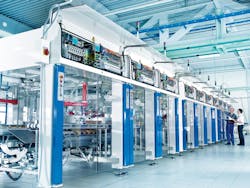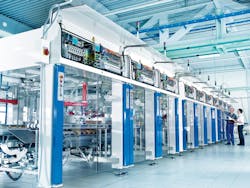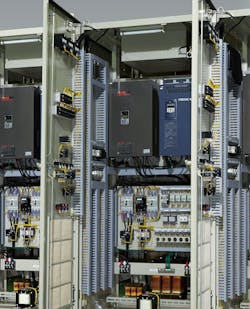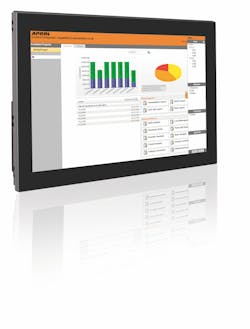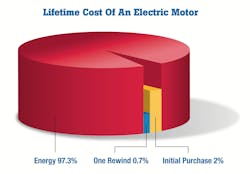Because of their increased intelligence capabilities, controllers offer the greatest opportunities to make closed-loop adjustments that translate into more efficient processes, suggests Danny Weiss, senior product manager at Newark element14. “Energy management functions can be embedded in controllers for managing various operating modes and diagnostics,” he says. “Because PLCs and PACs have increased their capabilities to handle more input and output, there’s less need for individual I/O modules. With the cloud and the Internet, you’re able to get remote access to smaller, more efficient and faster-running equipment. Even the controllers themselves are a lot smaller.”
Figure 1: Pneumatic cylinders are used in pick-and-place applications for filling trays with food items.
The control cabinet can be structured accordingly to improve thermal management and efficiency. “Smaller, more efficient components mean less heat dissipation, which allows for smaller fans,” says Weiss. “Using fewer components reduces the wiring, thus reducing the heat. Because the signal is now digital, as opposed to analog, it is more efficient so less energy is required to send the signal.” Reducing heat also helps to preserve electronic equipment and reduce breakdowns.
“We see the increased use of intelligent pressure control, such as reducing the pressure on a no-load return stroke for a cylinder, which is easily accomplished by adding a pressure regulator but greatly increases efficiency,” says John Bridges, technical business manager at Aventics. “Increasingly, pressure regulators are being integrated into custom valve manifolds that we build (Figure 1).”
The Internet of Things includes things, such as machines, says Mary Burgoon, market development manager at Rockwell Automation. “How do the machines in a plant talk to each other to modulate production when there is a blockage or a machine goes down?” she asks. “Do they automatically send a machine-to-machine (M2M) signal to shut it down and slow down production until that machine can come back online? The next target is dependency and smart connections from machine to machine.”
Also Read: Industrial Motors and Drives Keep Improving
Everything electrical is sized based on the amount of current that goes through it, so if you can reduce your energy consumption on each individual machine by 5% or 10%, it allows your energy infrastructure to handle more with a smaller system, explains Rich Mintz, product manager for gear motors at Siemens. “You see that all the way down to the drive train,” he says. “For example, a two-stage bevel gearbox and a worm gearbox are about the same size and have almost the same form fit function from the outside, but because of the inefficiency inside of the mechanical system, you’re going to lose one-half to one-third of the energy that you put into the worm gearbox. That means buying more motor, a larger drive and a larger circuit breaker than you would need with the two-stage bevel gearbox. That adds up pretty fast.”
Predictions
Figure 2: Higher-efficiency permanent-magnet motors will be deployed and require drives with new control algorithms incorporated into drives.
Source: Fuji Electric
“With the new Small Motor Rule in March 2015 and the Integral Horsepower Rule in June of 2016, adoption of premium-efficient motors could exceed 90% of the motors sold for use in the United States,” says John Malinowski, senior manager of industry affairs at Baldor Electric. “The U.S. Department of Energy (DOE) is working on regulations to control system efficiency for pumps, fans and compressors that are expected to take effect in 2019-2020. Plus, the Extended Motor Product Label Initiative (EMPLI) incentives could cause development of systems that will be above the DOE regulations, causing further energy savings.”
Higher-efficiency permanent-magnet motors will be deployed and require drives with new control algorithms, explains David Schrader, product manager at Fuji Electric Corp. of America. “Some of our drives already incorporate algorithms that allow for control of PM motors,” he says (Figure 2).
“At a minimum, I believe end users of machines are going to require machine builders to provide energy usage information to plant-wide energy monitoring systems,” says Corey Morton, director of technology solutions at B&R Industrial Automation. “Machine builders will need to adopt industry standards such as OPC UA to provide the needed connectivity in a uniform way (Figure 3).”
Figure 3: Users of machines are going to require machine builders to provide energy usage information to plant-wide energy monitoring systems.
Source: B&R Automation
Where machines start to play a role in lean Six Sigma principles is connected smartness, variable manufacturing and work in progress (WIP), says Phil Kaufman, energy technology manager at Rockwell Automation. “I can see a day where machines will start to turn on and turn off and use WIP in between them,” he predicts. “For instance, machines A and C will run and build WIP, and, when they go into a low power state and B comes up, it will consume the WIP and create new WIP before going back to sleep. This provides the opportunity to save energy, even while manufacturing at a lower throughput.”
Kaufman sees the connectivity moving into how energy is optimized economically. “Say I have a contractual requirement to reduce my load in the next hour. Can I do demand management by reducing my load on the shop floor and still meet my manufacturing needs?” he asks.
“With all machines speaking the same language and looking at the production schedule, it becomes predictive and self-modulating,” adds Rockwell Automation’s Burgoon. “It’s really future-state but probably not that far off, given where communication protocols and the technology and sensors are going.”
The purchasing paradigm must also change. “Purchasing folks must get onboard with strategies to save energy and purchase equipment that is more productive,” suggests Malinowski. “Many of them are schooled to save on first cost, which is mostly in conflict with energy efficiency or even productivity. A motor’s first cost is just 2% of the life cost, whereas over 97% is for energy used for its operation (Figure 4).”
Figure 4: A motor’s first cost is just 2% of the the life cost, whereas 97% is for energy used during its operation.
Source: Baldor Electric
Energy-smart machine designers will be able to offer their customers the opportunity to include energy as a line item in the bill of materials of the product being produced, suggests Arun Sinha, engineer at Opto 22.
“In the end-user world, one of the things we see down the road is that facilities will start to track energy down to the machine level the same way they track scrap, cycle time and things like that,” predicts Siemens’ Mintz. “Every decision is different from plant to plant and process to process. It’s important to understand the options so that you as an engineer can take that information and design your machines to save energy, and make yourself or your customer more competitive.”
About the Author
Sheila Kennedy
contributing editor

Leaders relevant to this article:
